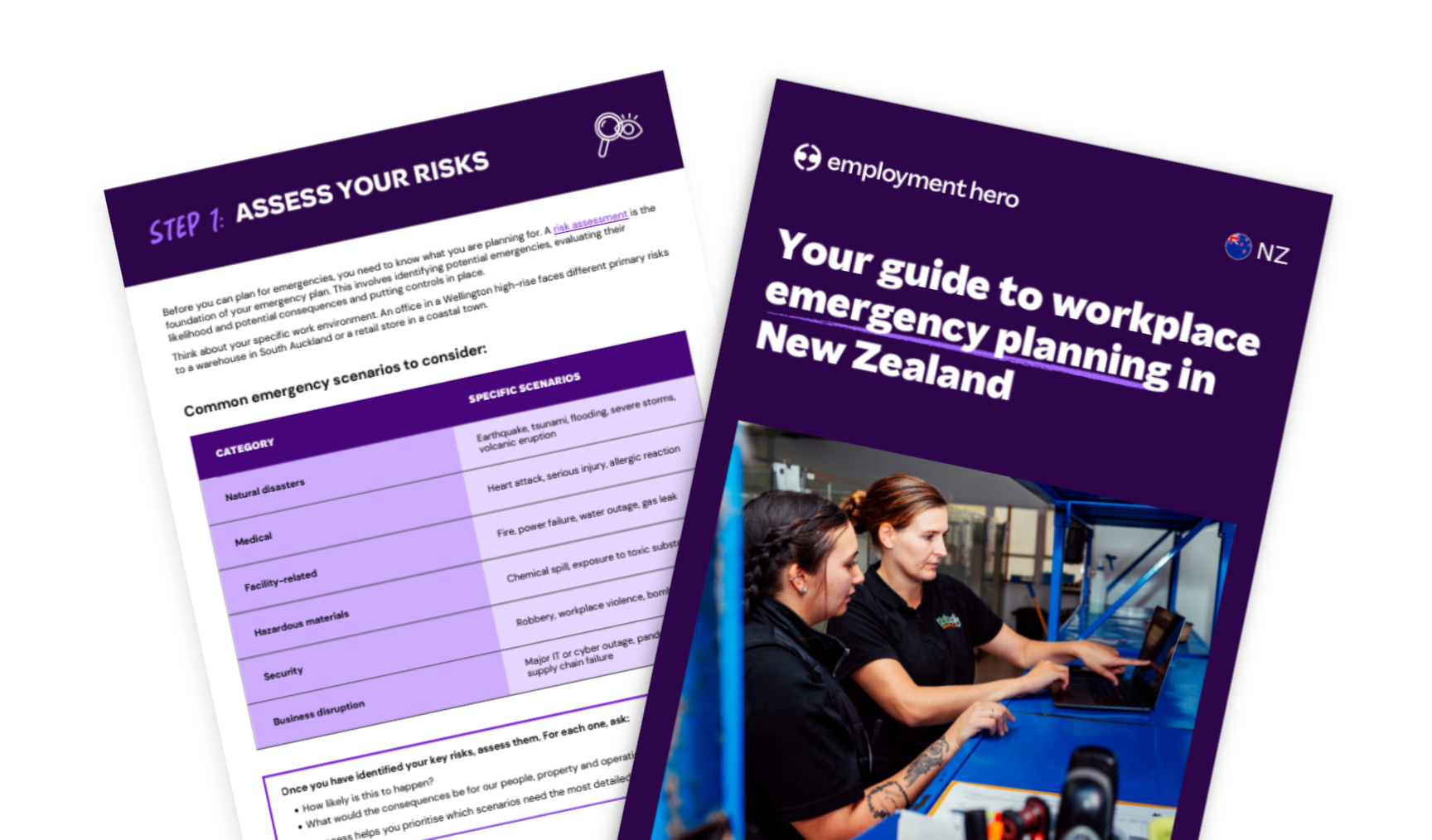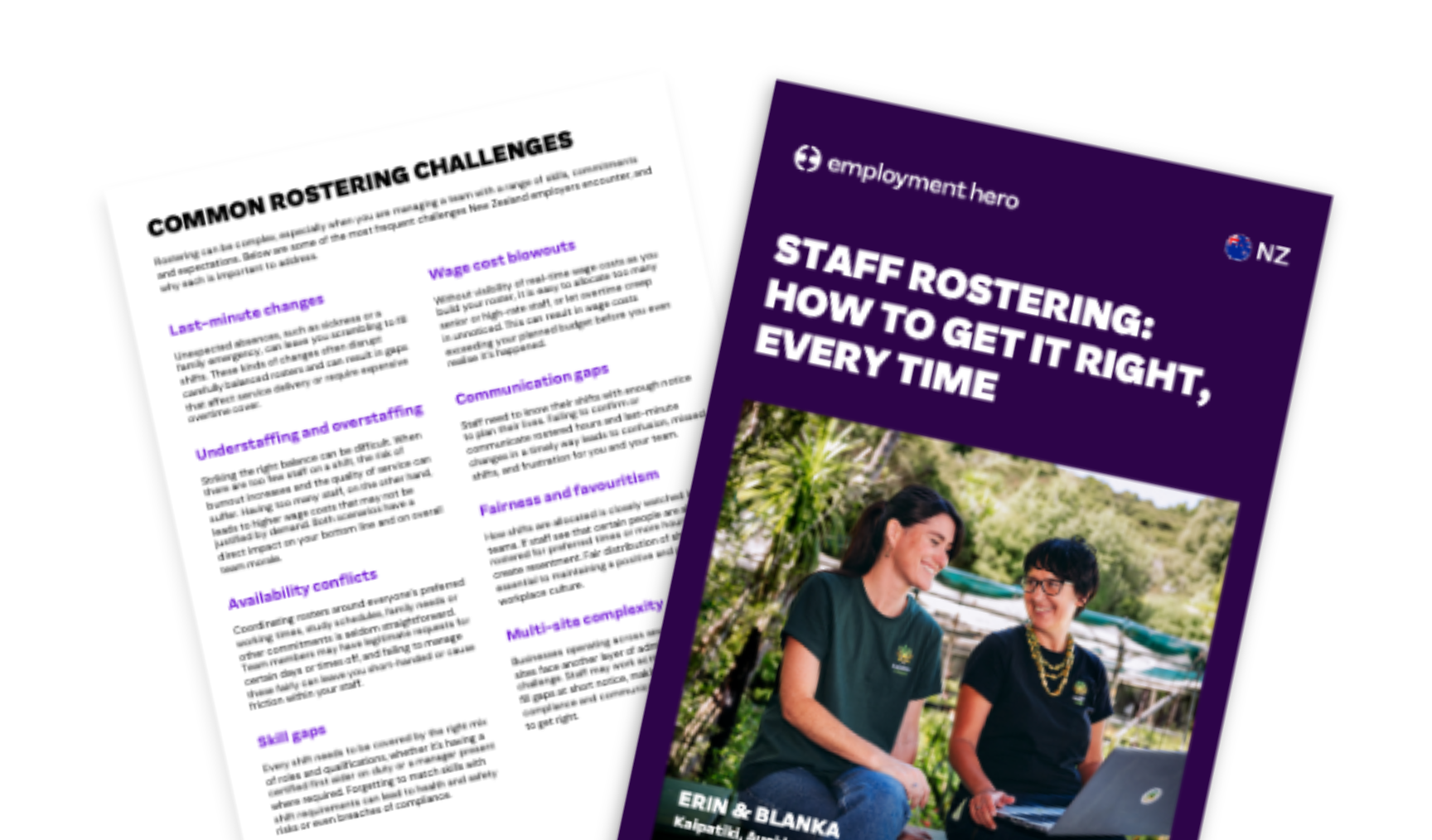Workplace emergency procedures: A guide for employers
Published
Workplace emergency procedures: A guide for employers
Emergencies happen, but that doesn’t mean there’s a need for panic. As an employer, you do what you can to respond to emergencies and keep everyone safe. We’ve put together a guide to help you cut through the complexity and create a plan that works.
We’ll take you through the importance of emergency planning, a range of situations you should be prepared for and how you can ensure your staff are properly trained for any emergency that may take place.
Our guide includes:
- Advice for risk assessments
- How to build an emergency plan
- Best practices for drills
- A template for a comprehensive workplace emergency plan
Why workplace emergency planning matters
Under the Health and Safety at Work Act 2016, it’s the responsibility of New Zealand workplaces to properly prepare for emergencies. The Act states that a Person Conducting a Business or Undertaking (PCBU) “must ensure that an emergency plan is prepared for the workplace”. As an employer, you have a responsibility to your employees to keep them safe.
There are also financial consequences for failing to prepare. The Act further states that “a PCBU who contravenes this regulation commits an offence and is liable on conviction, for an individual, to a fine not exceeding $10,000; for any other person, to a fine not exceeding $50,000.”
What to include in an emergency plan
The Health and Safety at Work Act 2016 outlines what must be included in an emergency plan. An emergency plan must include:
- Evacuation procedures
- Procedures for notifying emergency services
- Medical treatment/assistance procedures
- Communication procedures
- Testing and training procedures
The Act also advises regularly maintaining the emergency plan, to ensure its ongoing effectiveness.
What to consider when making an emergency plan
When you’re developing your emergency plan, there are a few things you’ll need to consider. These include:
- Workplace-specific risks. For example, is your workplace in a natural disaster-prone area, will you experience fires/hazardous spills etc?
- What roles can your employees play in your emergency planning?
- Do they have any accessibility needs that you need to take into consideration?
- How will you communicate your emergency procedures?
- How will you train your staff so they understand your emergency procedures?
Potential emergency scenarios
There are various common emergencies that you should be prepared for in New Zealand. Here’s how you can plan to manage some of the most common emergency scenarios.
Damaged buildings
If your building experiences damage as a result of fire or a natural disaster, then you need to keep your employees safe. You should identify any immediate risks to your staff if the building is currently damaged, before cordoning off any damaged areas of the building.
Next, gather everyone in the safest assembly spot and relocate them through the nearest safe exit in your building. Once everyone is safely evacuated, complete a damage assessment.
Staff can’t leave the building
Lockdowns, fires or external hazards can all result in your staff being unable to leave the building. You can plan to keep them safe by identifying and locating safe places in your building where they can take shelter.
Then, make sure your staff, including those with designated roles, understand where they can evacuate to.
Finally, have clear communication plans in place to let everyone know whether they must remain in the building.
Staff can’t take their usual transport to get home
Sometimes, your staff won’t be able to get home from work safely, due to natural disasters or medical emergencies. In these cases, you should look to arrange carpooling, based on who lives nearby (if safe to do so). You should also arrange accommodation (if necessary) for any staff affected.
Your emergency planning should prioritise getting staff home safely and have a range of methods for getting them home, so you’re not reliant on any one mode of transport.
People are seriously injured
No matter your industry, people can get seriously injured at work. Whether you’re in a high-risk workplace or an office, injuries do occur. If someone gets injured while at work you should notify the relevant authorities (eg. call for an ambulance) and have trained staff members who can administer first aid.
Once the immediate incident has been attended to, record what has happened along with key details, such as the location, injury and cause. You should also notify WorkSafe, so they’re aware of the incident.
Natural disasters in New Zealand
Spanning a fault line in the Earth’s surface, New Zealand is no stranger to natural disasters. There are a range of natural disasters that may affect your workplace, such as earthquakes, flooding and volcanic events.
In each instance, like with other emergencies, having proper evacuation procedures in place and a way of providing first aid (if needed) can help better protect your staff.
Fire or hazardous substance spills
Some workplaces are more at risk of fire and hazardous substance spills. In these cases, you should evacuate all affected staff members, report the incident to relevant authorities and secure the location, so no-one attempts entry.
In the case of hazardous substance spills, there may be a temptation to clean these up yourself. Instead, leave it to professionals, as they’re more likely to have the required experience, as well as the right personal protective equipment (PPE).
Worker engagement in emergency planning
As a business, you have an obligation to involve your workforce in emergency planning. To make sure they’re engaged, you should look to:
- Consult staff at every stage of the emergency planning process
- Have regular feedback sessions to ensure proper understanding
- Run regular drills and workshops to unpack specific plans in more detail
- Co-design emergency plans with a wide range of stakeholders from your workforce, so they’re tailored to your staff’s needs
Maintaining and testing emergency plans
You should look to test your emergency plans at least annually, as well as after significant updates (for example, real-life incidents elsewhere). All updates should be recorded in your key emergency documentation and communicated to the wider workforce.
Drills can also help you test your emergency plans. Regular fire drills, lockdown drills and medical emergency drills can all help you assess how your workforce may react in the case of an emergency, and where you can improve their preparedness.
Roles and responsibilities during emergencies
During an emergency, people need to know what roles they’ll be playing within your workforce. Key roles include:
- Fire wardens: Responsible for identifying hazards, and ensuring everyone evacuates successfully during an emergency
- First aid officers: Responsible for administering first aid to anyone that needs it
- Communications leads: Responsible for communicating emergency procedures to the wider workforce
To define these roles, you’ll need to first identify who in your workforce may be the best fit for each. From there, you’ll need to provide them with defined duties, as well as the proper training.
You should also involve them in developing and improving your emergency planning procedures as ultimately, they’re all a key part of executing them in the case of an emergency.
Training staff for emergency readiness
It’s important to make sure your staff are ready for emergencies. To help prepare them, you should:
- Include emergency readiness as part of their induction training, including explaining your emergency planning procedures
- Offer regular refresher courses, especially for longer-term employees
- Implement scenario-based practice, including fire drills, so people can test their readiness
Technology and tools to support emergency planning
There are various technologies and tools available to help streamline your emergency planning. For example, Employment Hero can help you manage your emergency planning through our safety features including logging emergency contacts, and lodging safety incident reports.
Our Document Management tool also makes it easy to issue documents to your workforce, so they can access all relevant emergency planning information.
These features make emergency planning more efficient and effective, while holding you and your team accountable, as your emergency planning documentation will be visible to the entire business.
Consequences of non-compliance with emergency procedures
There are many consequences that come with a failure to comply with emergency procedures. These could include lawsuits, heavy fines and reputational damage.
Planning for emergencies should be one of your biggest priorities as a business. Take the time to lay out comprehensive plans, as it can make your employees feel much more comfortable.
Download the full guide
Keeping your employees safe is one of the most important parts of being a manager. Having a robust, stress-tested emergency management plan can help you keep your workforce safe when it matters most, as well as give them the confidence that you’re always looking out for them.
Ready to start developing your emergency plans? Download our guide today and give your team the confidence that you’re always looking out for them.
The information in this article is current as at 30 October 2025, and has been prepared by Employment Hero Pty Ltd (ABN 11 160 047 709) and its related bodies corporate (Employment Hero). The views expressed in this article are general information only, are provided in good faith to assist employers and their employees, and should not be relied on as professional advice. Some information is based on data supplied by third parties. While such data is believed to be accurate, it has not been independently verified and no warranties are given that it is complete, accurate, up to date or fit for the purpose for which it is required. Employment Hero does not accept responsibility for any inaccuracy in such data and is not liable for any loss or damages arising directly or indirectly as a result of reliance on, use of or inability to use any information provided in this article. You should undertake your own research and seek professional advice before making any decisions or relying on the information in this article.
Register for the guide
Related Resources
-
 Read more: Workplace emergency procedures: A guide for employers
Read more: Workplace emergency procedures: A guide for employersWorkplace emergency procedures: A guide for employers
Learn how to create and maintain workplace emergency procedures. Discover legal requirements, potential scenarios, staff engagement and testing plans.
-
 Read more: Unlock Time and Efficiency: Driving Non-Stop Productivity in Your Queenstown Business
Read more: Unlock Time and Efficiency: Driving Non-Stop Productivity in Your Queenstown BusinessUnlock Time and Efficiency: Driving Non-Stop Productivity in Your Queenstown Business
Is administrative burden holding your management team back from strategic growth? For Queenstown businesses, maximizing every hour is critical. The…
-
 Read more: Staff rostering: A complete guide for NZ employers
Read more: Staff rostering: A complete guide for NZ employersStaff rostering: A complete guide for NZ employers
Discover how to manage staff rostering. Learn about common challenges, legal requirements and strategies for fair and efficient scheduling.




















